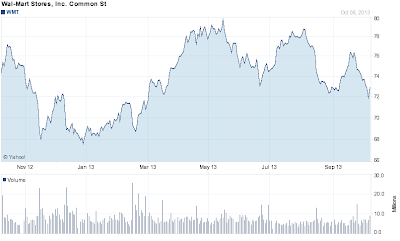Astounding Retail Sales Justify Fed Taper
Our founder earned clients a 23% average annual return over five years as a stock analyst on Wall Street. "The Greek" has written for institutional newsletters, Businessweek, Real Money, Seeking Alpha and others, while also appearing across TV and radio. While writing for Wall Street Greek, Mr. Kaminis presciently warned of the financial crisis.
Retail Sales
Upward Revision to October
The prior month’s sales data was revised higher, and the revisions extended across the board. This is not always good news, because it could lead to a slower growth rate for the reported month, since the base that growth is calculated upon is raised. However, that was not the case Thursday, as the prior month’s upward revision joined the current month’s positive surprise in uplifting hope.
Revised Oct. Change
|
Initial October Data
|
|
Retail Sales M/M Change
|
+0.6%
|
+0.4%
|
Retail Sales Less Autos
|
+0.5%
|
+0.2%
|
Retail Sales Less Autos &
Gas
|
+0.6%
|
+0.3%
|
As you can see, previously reported headline retail sales were increased two-tenths to +0.6% for October. When we exclude automobile and gasoline sales, growth shows up even better, improved by three-tenths of a percentage point. So this is good news about the pre-holiday period. It’s even more impressive if we recall the federal fiscal chaos that enveloped the headlines in early October as the government shut down and the debt ceiling debate threatened to derail the American economy. Those key factors did have a detrimental impact upon reported consumer sentiment trends through the month. Yet, as Thursday’s data shows, real spending came through okay.
November’s Good News
November Change
|
Economists’ Consensus
|
|
Retail Sales M/M Change
|
+0.7%
|
+0.6%
|
Retail Sales Less Autos
|
+0.4%
|
+0.3%
|
Retail Sales Less Autos &
Gas
|
+0.6%
|
+0.2%
|
Despite the upward revisions to October’s data, growth exceeded economists’ expectations across the board in November. The numbers were more than just better than expectations; they were strong in absolute terms as well. November retail sales growth of 0.7% beat the economists’ very positive outlook, but when excluding strong auto sales and gasoline, they blew away the economists’ consensus and remained robust in absolute terms at +0.6%.
I caught a so-called expert criticize the report on financial television Thursday. He expressed his view that retail sales are strong, but retailers’ individual earnings have been poor. He vaguely suggested that this was because of necessary discounting and reflected a generally poor retail environment. While I agree that the retail store capacity of the United States has typically been oversaturated over the last decade, I cannot find much fault with the latest retail sales report. And it is well-established now that American consumers are deal seekers.
I do believe that the earlier discounting of retailers may have helped pull forward a larger portion of seasonal sales than usual though. Opening on Thanksgiving like Wal-Mart (NYSE: WMT) and Target (NYSE: TGT) did and the beginning of discounting even earlier than that, along with ongoing daily deals from the likes of Best Buy (NYSE: BBY) and others, have certainly helped frontload seasonal sales. I think you can see that in the year-to-year comparisons. Sales were 4.7% greater in this year’s November versus last year, and they were up 4.1% for the September through November period.
Looking at the retail segments, autos were especially strong, with those sales up 1.8% in November and 10.9% against the prior year period. The strong November was already noted by Ford (NYSE: F) shares though because of the monthly motor vehicle sales data reported earlier this month, so auto stocks hardly reacted to the news Thursday.
Gasoline stations posted a 1.1% decline in sales for the month and a 3.3% drop from the prior year period. This activity is always dictated by the volatile price of the commodity. We can see that the auto and gasoline sales trends offset one another, and so the headline comparisons nearly matched the change in the adjusted figure that excludes these two important retail segments.
Online sales are of great interest to us, given their growing importance and the rising prominence of players in the market like Amazon.com (Nasdaq: AMZN). The sales of “nonstore retailers,” which also include exclusive catalog sellers but are mostly driven by online retailers these days, increased 2.2% in November and were up 9.4% against the prior year. The faster pace of growth reflects the still increasing importance of Internet retailers and their steady market share gains. That trend is driven by the ease of online shopping and the often better pricing of goods online.
Another positive sign for consumer spending was evident in the 1.3% higher sales of food services and drinking places in November, and 5.2% year-to-year increase. The outsized gain in sales for this segment is important, as we believe it offers evidence of casual dining gains. Eating at Darden Restaurants’ (NYSE: DRI) Olive Garden is relatively inexpensive, but it’s probably still more expensive than eating in. Eating at McDonalds (NYSE: MCD) is another story, thanks to its expanding dollar menu. I think the growth in this segment more likely reflects a return of consumer spending following improving labor trends.
Real estate enthusiasts will be happy to note the 1.8% month-to-month and 5.3% year-to-year sales growth in building materials stores. Add to that the 1.2% and 9.7% sales growth at furniture and home furnishings stores and we have real reason to celebrate. Not only are home sales increasing, but people are actually furnishing and repairing them.
The retail sales data on Thursday hardly lifted stocks, which were on the decline of late due to rising concern about Fed tapering and next week’s meeting of the U.S. central bank. Still, the slide in the SPDR S&P 500 (NYSE: SPY) did stall on the day, and that might have been because of the especially positive retail sales result. It is yet another data point offering evidence that the Fed might be justified in tapering back asset purchases now, and that the economy can stand on its own even so.
Please see our disclosures at the Wall Street Greek website and author bio pages found there. This article and website in no way offers or represents financial or investment advice. Information is provided for entertainment purposes only.

Labels: Economic-Reports, Economy, Economy-2013-Q4, Federal_Reserve, Federal-Reserve-2013-Q4, INDUSTRY-Retail-Stores, SECTOR-Consumer-Discretionary




























